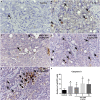Antitumor Effects of Cannabinoids in Human Pancreatic Ductal Adenocarcinoma Cell Line (Capan-2)-Derived Xenograft Mouse Model
- PMID: 35937289
- PMCID: PMC9353045
- DOI: 10.3389/fvets.2022.867575
Antitumor Effects of Cannabinoids in Human Pancreatic Ductal Adenocarcinoma Cell Line (Capan-2)-Derived Xenograft Mouse Model
Abstract
Background: Pancreatic cancer is considered a rare type of cancer, but the mortality rate is high. Cannabinoids extracted from the cannabis plant have been interested as an alternative treatment in cancer patients. Only a few studies are available on the antitumor effects of cannabinoids in pancreatic cancer. Therefore, this study aims to evaluate the antitumor effects of cannabinoids in pancreatic cancer xenografted mouse model.
Materials and methods: Twenty-five nude mice were subcutaneously transplanted with a human pancreatic ductal adenocarcinoma cell line (Capan-2). All mice were randomly assigned into 5 groups including negative control (gavage with sesame oil), positive control (5 mg/kg 5-fluorouracil intraperitoneal administration), and cannabinoids groups that daily received THC:CBD, 1:6 at 1, 5, or 10 mg/kg body weight for 30 days, respectively. Xenograft tumors and internal organs were collected for histopathological examination and immunohistochemistry.
Results: The average tumor volume was increased in all groups with no significant difference. The average apoptotic cells and caspase-3 positive cells were significantly increased in cannabinoid groups compared with the negative control group. The expression score of proliferating cell nuclear antigen in positive control and cannabinoids groups was decreased compared with the negative control group.
Conclusions: Cannabinoids have an antitumor effect on the Capan-2-derived xenograft mouse model though induce apoptosis and inhibit proliferation of tumor cells in a dose-dependent manner.
Keywords: Capan-2; cannabinoids; mouse; pancreatic cancer; xenograft tumor model.
Copyright © 2022 Sakarin, Meesiripan, Sangrajrang, Suwanpidokkul, Prayakprom, Bodhibukkana, Khaowroongrueng, Suriyachan, Thanasittichai, Srisubat, Surawongsin and Rattanapinyopituk.
Conflict of interest statement
NS, PP, CB, and VK were employed by The Government Pharmaceutical Organization. The remaining authors declare that the research was conducted in the absence of any commercial or financial relationships that could be construed as a potential conflict of interest.
Figures







References
-
- Belizario J. Immunodeficient mouse models: an overview. Open J Immunol. (2009) 2:79–85. 10.2174/1874226200902010079 - DOI
LinkOut - more resources
Full Text Sources
Research Materials

